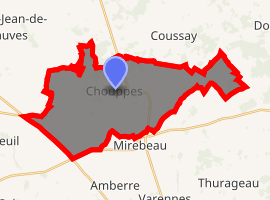Chouppes
Chouppes is a commune in the Vienne department in the Nouvelle-Aquitaine region in western France.
Chouppes | |
|---|---|
Location of Chouppes 
| |
 Chouppes  Chouppes | |
| Coordinates: 46°48′44″N 0°09′54″E | |
| Country | France |
| Region | Nouvelle-Aquitaine |
| Department | Vienne |
| Arrondissement | Châtellerault |
| Canton | Loudun |
| Government | |
| • Mayor (2008–2014) | Benoît Prinçay |
| Area 1 | 31.72 km2 (12.25 sq mi) |
| Population (2017-01-01)[1] | 750 |
| • Density | 24/km2 (61/sq mi) |
| Time zone | UTC+01:00 (CET) |
| • Summer (DST) | UTC+02:00 (CEST) |
| INSEE/Postal code | 86075 /86110 |
| Elevation | 79–157 m (259–515 ft) (avg. 85 m or 279 ft) |
| 1 French Land Register data, which excludes lakes, ponds, glaciers > 1 km2 (0.386 sq mi or 247 acres) and river estuaries. | |
History
Like the rest of France, Chouppes and Poligny welcome the advances of the French Revolution. Thus they plant their tree of freedom, as common symbol of the Revolution. It becomes the rallying point of all the festivals and major revolutionary events, such as the burning of securities feudal Poligny November 17, 1793 or the celebration of the recapture of Toulon to the English 19 January 1794. The neighboring town of Poligny is attached to Chouppes in 1848. Another tree of liberty planted in 1948 to celebrate the centenary of the French Revolution of 1848.[2]
Toponymy
The name of the village comes from the name of the lord of the place: Petrus de Chaoppa. The origin would be Catuoppus, Gaulish word meaning the eye of the fight.[3][4][5]
Demographics
| Year | 1962 | 1968 | 1975 | 1982 | 1990 | 1999 | 2006 |
|---|---|---|---|---|---|---|---|
| Population | 519 | 634 | 574 | 674 | 740 | 693 | 738 |
The evolution of the number of inhabitants is known through the censuses of the population carried out in the commune since 1793. As of 2006, the legal populations of the communes are published annually by the INSEE. The census is now based on an annual collection of information, successively covering all municipal territories over a period of five years. For municipalities with fewer than 10,000 inhabitants, a census survey of the entire population is conducted every five years, the official population of middle years themselves being estimated by interpolation or extrapolation.[6] For the municipality, the first comprehensive census within the framework of the new system was carried out in 2006.[7]
Economy
According to the Regional Directorate for Food, Agriculture and Forestry of Poitou-Charentes, there are only 44 farms in 2010 against 69 in 2000. Agricultural land used increased by 10% from 2,726 hectares in 2000 to 2,999 hectares in 2010. These figures indicate a concentration of land on a smaller number of farms. This trend is in line with developments in the entire Vienne département since from 2000 to 2007, each farm gained an average of 20 hectares. 57% of agricultural land is intended for cereals (mainly soft wheat but also barley and maize), 26% for oilseeds (rapeseed and sunflower), 6% for fodder and 2% for herbs. In 2010, 23 hectares (22 in 2000) are devoted to the vine for the production of Haut-Poitou AOC. The vineyard is managed by nine farms in 2010 against 23 in 2000. Four farms in 2010 (against ten in 2000) are home to a cattle farm (195 in 2010 against 575 in 2000). Five farms in 2010 (compared to eight in 2000) are home to a sheep farm (242 head in 2010 against 199 head in 2000). Poultry farming disappeared in 2010 (4,873 head of 35 farms in 2000).[8]
See also
References
- "Populations légales 2017". INSEE. Retrieved 6 January 2020.
- Christophe Quillien, Paris, Flammarion, octobre 2009 (ISBN 978-2-081-22166-6)
- The common heritage of Vienna in 2 volumes - FLOHIC Edition - 2002 - (ISBN 2-84234-128-7)
- Pierre Gauthier, places of Poitou names , Bonneton,1996, 232 p. (ISBN 2-86253-201-0), p. 60
- Xavier Delamarre, Dictionary of the Gallic language , Wandering,2003440 p. (ISBN 2-87772-237-6), p. 270
- "Présentation du recensement de la population | Insee". www.insee.fr. Retrieved 2018-12-28.
- "Documentation sur les résultats du recensement | Insee". www.insee.fr. Retrieved 2018-12-28.
- Nouvelle-Aquitaine, DRAAF (2018-12-21). "DRAAF Nouvelle-Aquitaine". draaf.nouvelle-aquitaine.agriculture.gouv.fr (in French). Retrieved 2018-12-28.
| Wikimedia Commons has media related to Chouppes. |